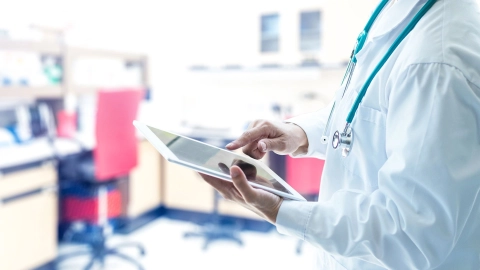Digital health Digitization in healthcare at a glance
Digital solutions are enriching the healthcare sector: important documents are no longer lost and video consultations are replacing many visits to the doctor. Apps on prescription complement the treatments. It is easier for medical personnel to view important information when required, e.g. emergency information or results.
At a glance
- Digitization is changing almost every aspect of healthcare.
- The electronic patient record (ePA) for all simplifies many processes and creates greater transparency.
- Digital health applications (DiGA) – also known as apps on prescription – can help with treatment.
- Telemedicine enables remote medical services, for example video consultations.
- Information is digitally transferred using the e-prescription and the electronic sick leave notice (eAU).

Digitization in healthcare – what is it?
Digitization in healthcare is in full swing: with the ePA for all, everyone with statutory health insurance will receive an electronic patient record (ePA) from 2025 unless they object to having one set up. Some private health insurance providers are also offering their members an ePA. Health apps that support and complement the treatment of various health conditions are already available on prescription. Telemedical solutions can also make some of the physical visits to medical practices unnecessary.
The dream of nationwide digital networking within the healthcare sector has now become a reality. The telematics infrastructure enables medical practices, hospitals, pharmacies and other German healthcare facilities to securely exchange information. To do this, technology that protects all patient data is used.
The goal is to connect all participants in healthcare with one another. Information required for treatment is therefore available in a direct and simple manner.
The following laws helped bring about particularly important progress in the digitization of healthcare:
- E-Health Act (2016)
- Digital Healthcare Act (DVG, 2019)
- Patient Data Protection Act (PDSG, 2020)
- Hospital Future Act (KHZG, 2020)
- Digital Care Modernization Act (DVPMG, 2021)
- Act to Accelerate the Digitalization of the Healthcare System (Digital Act – DigiG, March 2024)
- Medical Data Use Act (GDNG, March 2024)
The E-Health Act provided the initial foundations for the development of the telematics infrastructure and the introduction of digital medical applications. The Digital Healthcare Act makes it possible, for example, for health apps (digital health applications or DiGA) to be paid for by health insurance providers and prescribed by doctors and psychotherapists.
The Patient Data Protection Act enables the use of digital services such as the electronic patient record or the e-prescription. The Hospital Future Act promoted investment in the digital future of hospitals to further expand modern emergency capacities and improve digitization and IT security. The Digital Care Modernization Act enabled the creation of new digital healthcare applications. The field of telemedicine has also been developed and modern networking in the healthcare sector has been promoted.
With the introduction of the new ePA for all, the Digital Act should drive the exchange and use of medical data. The Medical Data Use Act should enable the use of medical data for research purposes.
What digital applications already exist?
Several electronic solutions intended to simplify workflows in the healthcare system have been introduced within the framework of digitization.
Medical data cards and electronic patient records
The electronic medical data card (eGK) has been used by patients as proof of insurance for doctor and dentist visits since 2015. In addition to master data such as the name and address of the insured person, emergency data can be saved to the card.
The introduction of the electronic patient record (ePA) marks another important step in the digitization of healthcare. In January 2025, everyone covered by statutory health insurance will receive an ePA for all from their health insurance provider. Anyone who does not wish to use the ePA for all can opt out at any time by contacting their health insurance provider. The ePA enables doctors to easily view important results, for example from previous visits to specialists or hospital stays.
This should enable patients to receive better and more efficient care, for example by reducing the number of duplicate examinations. With the electronic patient record, patients can also view their own medical documents in the ePA app at any time.
From the eAU to apps on prescription
The electronic sick leave notice (eAU) has replaced the paper version since 2021. All prescriptions are now issued digitally in the form of e-prescriptions. They can be redeemed at a pharmacy using an electronic medical data card, a smart phone or as a printout.
Numerous health apps and web applications are already available on prescription from doctors and psychotherapists. These digital health applications (DiGA) can support and complement the treatment of a number of conditions.
Telemedicine: remote healthcare
Telemedicine offers a variety of digital services that complement physical visits to a doctor or medical practitioner. Video consultations via a computer or smartphone can save travel and wait times. Medical professionals can use tele-expertise to exchange information more easily and collaborate more successfully.
Another area of telemedicine is telemonitoring. This includes the electronic recording, transfer and monitoring of important health indicators, such as blood pressure or heart rate. Patients can use apps to share such health indicators with their doctors.
Is the patient data secure?
From the electronic patient record (ePA) through the use of digital health applications (DiGA) to online consultations, data protection and data privacy are key to sustainable digitization in the healthcare sector.
Patients have a right to the best possible protection of their medical data. Data privacy and data protection issues are therefore dealt with carefully in all areas of digitization.
Research and health: digital data for new insights
The heightened level of digitization in the healthcare sector is creating large volumes of medical data. Medical data contains valuable information with regard to researching health and illness as well as for improving medical care.
This kind of extensive data is also known as big data. For example, suitable analysis methods can make it easier to identify relationships between risk factors and health conditions. This enables medical practitioners and pharmacists to develop new methods and treat people more individually.
In the future, it should be possible to voluntarily donate pseudonymized medical data from the electronic patient record (ePA) for research purposes. As in all areas of healthcare digitization, extensive measures to protect data are also being taken in the field of research.
- Bundesärztekammer (BÄK). Elektronische Arbeitsunfähigkeitsbescheinigung. Aufgerufen am 30.10.2024.
- Bundesinstitut für Arzneimittel und Medizinprodukte. Wissenswertes zu DiGA. Aufgerufen am 30.10.2024.
- Bundesministerium für Bildung und Forschung, Bundesministerium für Gesundheit, Bundesministerium für Wirtschaft und Energie. Daten helfen heilen. Aufgerufen am 24.10.2024.
- Bundesministerium für Gesundheit. Daten für die Forschung und Versorgung. Aufgerufen am 24.10.2024.
- Bundesministerium für Gesundheit. Die elektronische Patientenakte für alle. Aufgerufen am 05.11.2024.
- Bundesministerium für Gesundheit. Digitalisierung im Gesundheitswesen. Aufgerufen am 25.10.2024.
- Bundesministerium für Gesundheit. Elektronische Gesundheitskarte. Aufgerufen am 30.10.2024.
- Bundesministerium für Gesundheit. Fragen und Antworten zum Gesundheitsdatennutzungsgesetz (GDNG). Aufgerufen am 24.10.2024.
- Bundesministerium für Gesundheit. Gesetz zur Beschleunigung der Digitalisierung des Gesundheitswesens (Digital-Gesetz – DigiG). Aufgerufen am 30.10.2024.
- Bundesministerium für Gesundheit. Gesundheitsdatennutzungsgesetz (GDNG). Aufgerufen am 30.10.2024.
- Data Saves Lives. Was versteht man unter “Big Data“? Aufgerufen am 24.10.2024.
- gematik GmbH. ePA für alle. Aufgerufen am 30.10.2024.
- gematik GmbH. E-Rezept – Der schnelle Weg zum richtigen Medikament. Aufgerufen am 30.10.2024.
- GKV Spitzenverband. Videosprechstunde, -betreuung/ telemedizinische Leistung per Video. Aufgerufen am 05.11.2024.
- Haserück, André; Kurz, Charlotte. Telemonitoring: Digitaler Lebensretter. Dtsch Arztebl 2023; 120(49): A-2073 / B-1761. Aufgerufen am 24.10.2024.
- Kassenärztliche Bundesvereinigung (KBV). Telekonsilien. Aufgerufen am 24.10.2024.
- Kassenärztliche Bundesvereinigung (KBV). Telemedizin. Aufgerufen am 24.10.2024.
- Verbraucherzentrale. Elektronische Patientenakte (ePA). Aufgerufen am 24.10.2024.
Reviewed by the German National Agency for Digital Medicine (gematik).
As at:





